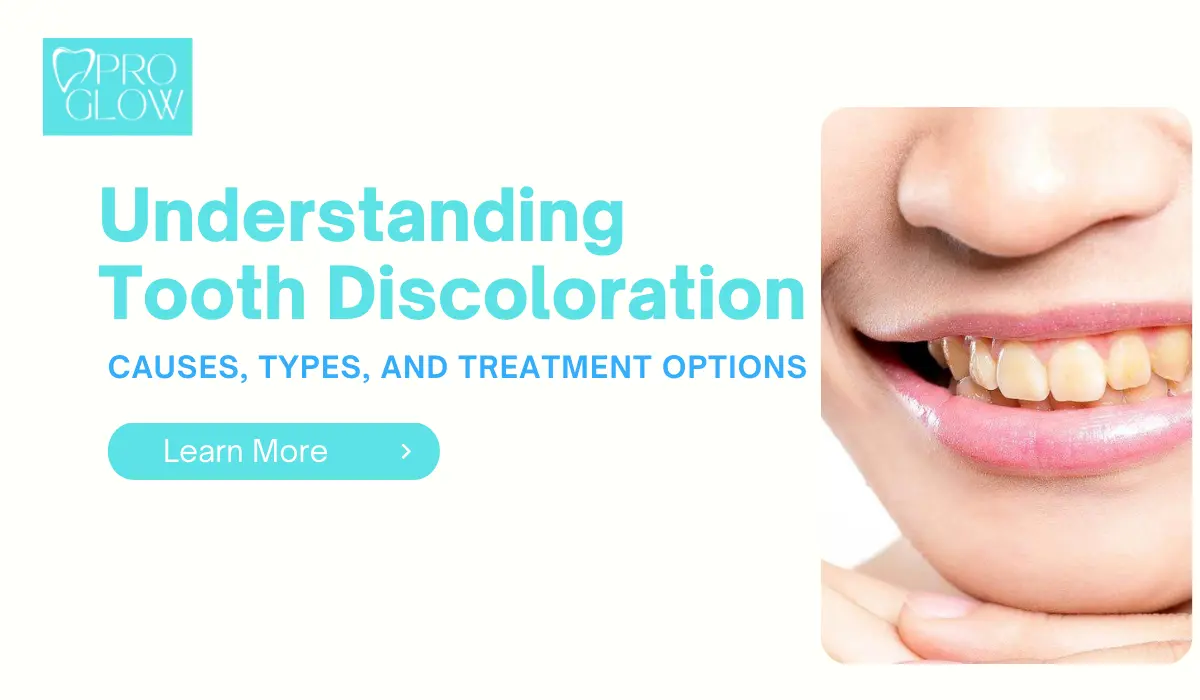May 9, 2024 lori
Understanding Tooth Discoloration: Causes, Types, and Treatment Options

A bright, white smile is often associated with health, vitality, and confidence. However, tooth discoloration can detract from the aesthetics of your smile and impact your self-esteem. Understanding the causes, types, and treatment options for tooth discoloration is essential for maintaining a radiant smile and achieving optimal oral health. In this comprehensive guide, we’ll delve into the various factors that contribute to tooth discoloration, explore the different types of discoloration, and discuss effective treatment options for restoring a bright, white smile.
Causes of Tooth Discoloration:
Tooth discoloration can result from a combination of intrinsic and extrinsic factors that affect the color and appearance of the teeth. Intrinsic discoloration occurs when the inner structure of the tooth, known as dentin, darkens or becomes stained. This type of discoloration is often caused by factors such as:
- Genetics: Some individuals may inherit genes that predispose them to tooth discoloration or enamel defects, resulting in a less vibrant smile.
- Age: As we age, the enamel on our teeth naturally wears down, revealing the yellowish dentin beneath and causing the teeth to appear duller and more discolored.
- Trauma: Injuries to the teeth, such as fractures or cracks, can disrupt the enamel and expose the underlying dentin, leading to discoloration.
- Medications: Certain medications, such as tetracycline antibiotics or antihistamines, can cause tooth discoloration, particularly if taken during childhood when the teeth are still developing.
Extrinsic discoloration, on the other hand, occurs when external factors stain the surface of the teeth. Common causes of extrinsic discoloration include:
- Foods and Beverages: Dark-colored foods and beverages such as coffee, tea, red wine, and berries contain pigments that can stain the enamel and contribute to tooth discoloration over time.
- Tobacco Use: Smoking or chewing tobacco products can lead to stubborn stains on the teeth, giving them a yellow or brownish appearance.
- Poor Oral Hygiene: Inadequate brushing and flossing can allow plaque and tartar buildup to accumulate on the teeth, leading to discoloration and enamel erosion.
- Environmental Factors: Exposure to environmental pollutants or chemicals can discolor the teeth, particularly in areas with high levels of fluoride or other minerals in the water supply.
Types of Tooth Discoloration:
Tooth discoloration can manifest in various forms, each with its own distinct characteristics and underlying causes. Common types of tooth discoloration include:
- Yellowing: Yellowing of the teeth is often associated with age-related changes in the enamel and dentin, as well as extrinsic factors such as diet and lifestyle habits.
- Brown or Gray Stains: Brown or gray stains on the teeth may be caused by factors such as smoking, consuming dark-colored foods and beverages, or certain medications.
- White Spots: White spots on the teeth can indicate areas of enamel demineralization or fluorosis, a condition that occurs due to excessive fluoride intake during childhood.
- Dark Bands or Lines: Dark bands or lines on the teeth may result from trauma or injury to the tooth, as well as certain developmental defects or genetic factors.
Treatment Options for Tooth Discoloration:
Fortunately, there are several treatment options available for addressing tooth discoloration and restoring a bright, white smile. The most appropriate treatment will depend on the type and severity of the discoloration, as well as the individual’s oral health needs and aesthetic goals. Common treatment options include:
- Professional Teeth Whitening: Professional teeth whitening treatments, such as those offered at Teeth Whitening Toronto, can effectively lighten and brighten discolored teeth. These treatments utilize bleaching agents to remove stains and lighten the color of the enamel, resulting in a noticeably whiter smile.
- Dental Bonding: Dental bonding involves applying a tooth-colored composite resin to the surface of the teeth to conceal imperfections such as stains, chips, or cracks. This minimally invasive procedure can improve the appearance of discolored teeth and enhance overall smile aesthetics.
- Porcelain Veneers: Porcelain veneers are thin, custom-made shells that are bonded to the front surface of the teeth to conceal imperfections and enhance their appearance. Veneers can effectively mask stubborn stains, discoloration, and other cosmetic concerns, providing a natural-looking and long-lasting solution for achieving a radiant smile.
- Dental Crowns: Dental crowns, or caps, are prosthetic restorations that cover the entire visible surface of a tooth to restore its shape, size, and appearance. Crowns can be made from various materials, including porcelain, ceramic, or metal, and can effectively conceal severe discoloration, damage, or decay.
Conclusion:
Tooth discoloration is a common concern that can affect individuals of all ages and backgrounds. By understanding the causes, types, and treatment options for tooth discoloration, individuals can take proactive steps to maintain a bright, white smile and improve their overall oral health. Whether seeking professional teeth whitening treatments, dental bonding, porcelain veneers, or other cosmetic procedures, consulting with a qualified dental professional is essential for achieving optimal results and restoring confidence in your smile. With the right treatment approach, you can enjoy a radiant smile that reflects your health, vitality, and personality for years to come.

